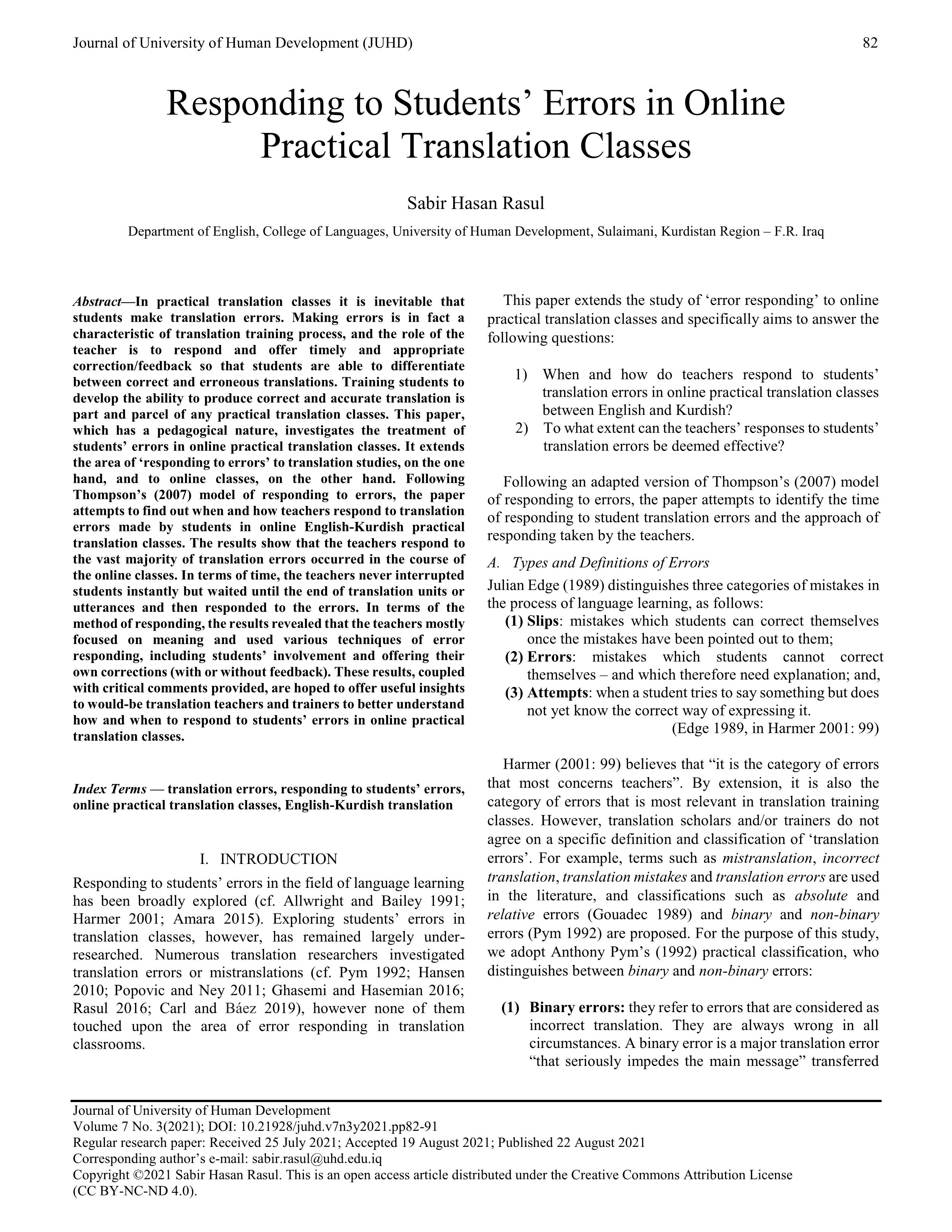Responding to Students’ Errors in Online Practical Translation Classes
DOI:
https://doi.org/10.21928/juhd.v7n3y2021.pp82-91Keywords:
translation errors, responding to students’ errors, online practical translation classes, English-Kurdish translationAbstract
In practical translation classes it is inevitable that students make translation errors. Making errors is in fact a characteristic of translation training process, and the role of the teacher is to respond and offer timely and appropriate correction/feedback so that students are able to differentiate between correct and erroneous translations. Training students to develop the ability to produce correct and accurate translation is part and parcel of any practical translation classes. This paper, which has a pedagogical nature, investigates the treatment of students’ errors in online practical translation classes. It extends the area of ‘responding to errors’ to translation studies, on the one hand, and to online classes, on the other hand. Following Thompson’s (2007) model of responding to errors, the paper attempts to find out when and how teachers respond to translation errors made by students in online English-Kurdish practical translation classes. The results show that the teachers respond to the vast majority of translation errors occurred in the course of the online classes. In terms of time, the teachers never interrupted students instantly but waited until the end of translation units or utterances and then responded to the errors. In terms of the method of responding, the results revealed that the teachers mostly focused on meaning and used various techniques of error responding, including students’ involvement and offering their own corrections (with or without feedback). These results, coupled with critical comments provided, are hoped to offer useful insights to would-be translation teachers and trainers to better understand how and when to respond to students’ errors in online practical translation classes.
References
Allwright, D., and Bailey, K. M. (1991). Focus on the Language Classroom: An Introduction to Classroom Research for Language Teachers. Cambridge: Cambridge University Press.
Amara, N. (2015). ‘Errors Correction in Foreign Language Teaching’. The Online Journal of New Horizons in Education. 5 (3), pp. 58–68.
Baker, M. (2018). In Other Words: A Coursebook on Translation. (3rd ed.) London and New York: Routledge.
Carl, M., and Báez, M. C. T. (2019). ‘Machine Translation Errors and the Translation Process: A Study across Different Languages’. Journal of Specialised Translation, (31), pp. 107–132.
Edge, J. (1989). Mistakes and Correction. New York: Longman.
Ghasemi, H. and M., Hasemian (2016). ‘A Comparative Study of Google Translate Translations: An Error Analysis of English-to-Persian and Persian-to-English Translations’. English Language Teaching. 9(3), pp. 13–17.
Gouadec, D. (1989). ‘Comprendre, évaluer, prévenir. Pratique, ensei- gnement et recherche face à l’erreur et à la faute en traduction’, TTR, 2(2), pp. 35–54.
Gower, R., Phillips, D. and Walters, S. (1995). Teaching Practice Handbook. Oxford: Macmillan Heinemann.
Hansen, G. (2010). Translation ‘Errors’. In: Gambier, Y., van Doorslaer, L. (eds). Handbook of Translation Studies. Amsterdam: John Benjamins, pp. 385–388.
Harmer, J. (2001). The Practice of English Language Teaching. Essex: Longman.
Ismail, S., Alsager, H. N., and Omar, A. (2019). ‘The Implications of Online Translation Courses on Instructors’ Philosophy of Teaching’. Arab World English Journal (AWEJ), Special Issue on CALL (5), pp. 176–189.
Kostić-Bobanović, M. (2007). ‘Should Teachers Correct Students’ Oral Errors?’ In: Međunarodni znanstveni i stručni skup. Sveučilište Jurja Dobrile u Puli, Odjel za obrazovanje učitelja i odgajatelja, Medulin, pp. 377–385.
Larson, M. L. (1998). Meaning-Based Translation: A Guide to Cross-Language Equivalence. (2nd ed.) Lanham, New York and London: University Press of America.
Lewis, C. C., and Abdul-Hamid, H. (2006). ‘Implementing Effective Online Teaching Practices: Voices of Exemplary Faculty’. Innovative Higher Education, 31(2), pp. 83–98.
Newmark, P. (1988). A Textbook of Translation. Hemel Hempstead: Prentice Hall International.
Popovic, M. and H., Ney (2011). ‘Towards Automatic Error Analysis of Machine Translation Output’. Computational Linguistics, 37(4), pp. 657–688.
Pym, A. (1992). Translation Error Analysis and the Interface with Language Teaching. In: C. Dollerup and A. Loddegaard, (eds.) The Teaching of Translation. Amsterdam/Philadelphia: John Benjamins, pp. 279–288.
Rasul, S. H. (2016). ‘Translation Constraints and Procedures to Overcome them in Rendering Journalistic Texts’. Journal of University of Human Development, 2(3), pp. 402–419.
Rasul, S. H. (2018). ‘Translation of Idioms across Languages’. Transletters. International Journal of Translation and Interpreting, 1, pp. 121–141.
Rasul, S. H. (2019). Journalistic Translation: Procedures and Strategies in English-Kurdish Translation of Media Texts. Newcastle: Cambridge Scholars Publishing.
Thompson, G. (1996). ‘Some Misconceptions about Communicative Language Teaching’. ELT Journal, 50(1), pp. 9–15.
Thompson, G. (2007). ‘Class Observation: Responding to Errors’ Form. MA in TESOL, School of English, University of Liverpool.
Thornbury, S. (1999). How to Teach Grammar. London: Longman.
Williams, M. (2004). Translation Quality Assessment: An Argumentation-Centred Approach. Ottawa: University of Ottawa Press.

Downloads
Published
How to Cite
Issue
Section
License
Copyright (c) 2021 Sabir Rasul

This work is licensed under a Creative Commons Attribution-NonCommercial-NoDerivatives 4.0 International License.


